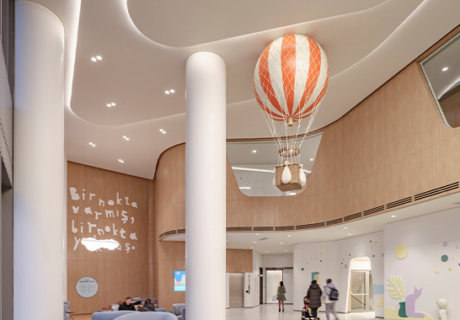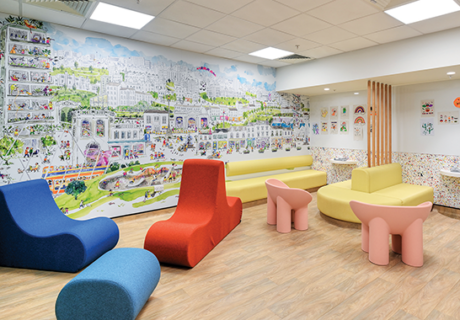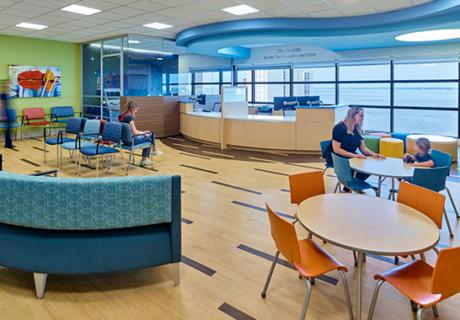Comeback Kid: Abraham Ezra To Life Foundation Activity Room
In 2012, Hospital for Special Surgery, a New York-based academic medical center focused on orthopedics and rheumatology, opened the Abraham Ezra To Life Foundation Activity Room in its pediatric unit to offer patients a space to gather with visiting friends and family members. Amenities housed there, including a TV, video games, and crafting supplies, also served as a fun form of motivation, with staff offering patients access to the room when they met their therapy goals.
Over the years, however, the space lost its appeal to both patients and staff. Its cluttered layout was difficult for patients, many of whom use wheelchairs or a walker post-surgery, to navigate. Additionally, inefficient storage, hard-to-access gaming devices, and a view that overlooked mechanical equipment on an adjacent rooftop weren’t very appealing.
“It just wasn’t working well for them,” says Lee H. Skolnick, principal and founder of Lee H. Skolnick Architecture + Design Partnership (New York), which was hired to renovate the room. “It had a lot of drawbacks and limitations because the space wasn’t used efficiently and effectively.”
In 2016, the hospital asked the foundation for funding to renovate the approximately 320-square-foot activity room. The project was guided by a list of improvements requested by the staff, including child life specialists, nurses, and pediatric rehabilitation specialists. Among their goals was an updated environment that would appeal to patients of different ages, abilities, and degrees of mobility.
Additionally, the group desired more storage and a layout and furnishings that could be reconfigured to meet different activity needs and user groups. “We wanted to make the room more open and flexible and also a bit lighter and brighter,” says Dr. Lisa S. Ipp, chief of pediatric medicine at Hospital for Special Surgery.
The new setting, which opened this spring, is organized into three zones: storage space for supplies and medical equipment located near the entrance; a central activity area in the middle; and a movie/game area at the back of the room with custom banquette seating and a wall-mounted flat-screen TV.
To solve the problem of the unappealing view from the windows at the rear of the room, designers created a custom mural of the New York skyline and Central Park that starts on one wall and continues onto a perforated scrim that’s placed in front of the windows, allowing light to enter the room and a colorful backdrop to the new setting.
A neutral material and color palette complements the artwork, such as wood-tone composite flooring and maple-colored millwork around the perimeter that incorporates storage and seating nooks. “We packed a lot into a small space,” Skolnick says.
Ipp says feedback on the renovation has been overwhelmingly positive. The openness of the space allows the staff to provide medical care when necessary, rather than transfer patients back to their rooms. Additionally, patients are reportedly more motivated to visit the room and engage in activities and for longer periods of time. “Children who see the room prior to their admission are eager to meet therapy goals in order to visit the room,” she says.
Anne DiNardo is executive editor of Healthcare Design. She can be reached at anne.dinardo@emeraldexpo.com.








